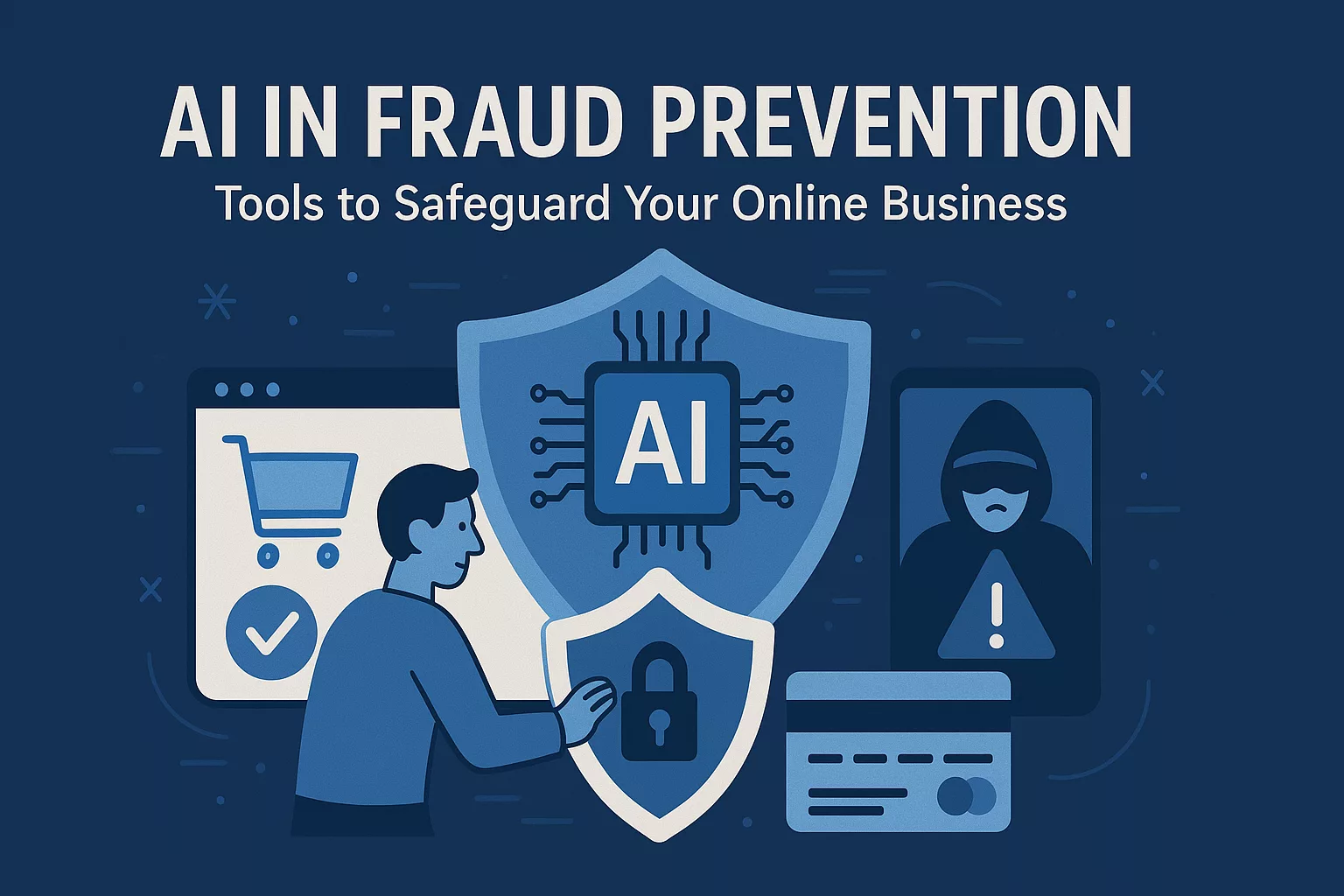AI in Fraud Prevention: Tools to Safeguard Your Online Business
The increased digitalization of businesses brought many benefits to both customers and companies. Customers can now research and make purchases from the comfort of their homes, while organizations are able to reach more people.
However, online operations expose companies to cyber threats and fraud. The monetary losses caused by cyber criminals went up to 12.5 billion dollars, which shows just how important it is to maximize your defenses against online threats.
Just like hackers find new ways of conducting attacks, so do cyber experts invent new methods of protecting against these. One of the latest trends is the use of AI in fraud prevention, and we’ve made a detailed breakdown of what that means. We’ve explored multiple types of tools that can be used to protect your online operations.
Online examples
Online fraud can come in many different forms. One of the most problematic examples is payment forgery. In this case, the hackers make unauthorized transactions from a stolen account or use stolen credit card data.
Account takeover is another serious threat businesses face. Fraudsters can steal credentials through cyberattacks like brute force, phishing, or social engineering. In some cases, instead of stealing accounts, they create fake ones using stolen credentials.
Threat intelligence solutions play a crucial role in staying ahead of these evolving tactics. By detecting emerging threats—like new phishing schemes or fraud attempts using stolen data—these solutions help businesses better protect themselves from increasingly sophisticated attacks.
Sometimes, fraudsters gain access to sensitive information from one platform due to a data breach or leak and use it to create fake accounts elsewhere. This underscores the importance of verifying the identities of all users when they create accounts, ensuring that fraudulent accounts don’t go undetected.
Phishing attacks include the creation of fake websites or personas that impersonate legitimate businesses and employees. This type of attack can be used to get credentials from your customers or employees.
How AI helps in fraud prevention
We’ve started seeing artificial intelligence being implemented basically everywhere in the past couple of years. While many of the tools use artificial intelligence hype simply to market themselves, AI in fraud prevention has significant potential.
AI systems offer real-time protection, which instantly flags suspicious transactions. This protection is automated and allows businesses to stop these transactions before they cause any harm.
Similarly, AI is also able to conduct behavioral analysis. Through analysis of user behavior, AI tools can help you recognize bots and fraudsters. For example, a user’s account is stolen, and the hacker conducts large transactions out of the blue, or they change the location.
AI learns from experience and continuously improves its detection capabilities. With many options on the market, you should certainly compare fraud detection software and find the solution that fits your requirements perfectly.
While all of these features are great, one of the best advantages that AI fraud prevention offers is automation. Companies don’t have to hire employees to individually check transactions, which is often impossible. Instead, the tool will automatically recognize problematic transactions and activities and report them to the right decision-makers.
Types of tools to leverage for protecting online businesses
Businesses need to implement a multi-layered strategy that protects multiple aspects of their operations. The list below should help with multiple aspects, and the tools range from traditional to innovative solutions.
Fraud prevention software
As already discussed, prevention software can protect against real-time threats and multiple types of cyber attacks. With real-time protection and risk scoring, problematic activities won’t go unnoticed.
This software prevents both customers and companies. It protects corporations from chargeback fraud, and it safeguards the consumers in the case of an account takeover, as it will prevent unauthorized transactions. It can be seamlessly integrated with payment gateways, websites, and other tools and services. Merchants can further strengthen this layer by using payments software that connects checkout, POS, and back-office systems, combining token vaulting and real-time risk scoring to block fraudulent transactions while preserving a smooth customer experience.
Identity and access management
Managing who has which permissions is one of the most important aspects of security for businesses. IAM tools ensure that only those who are authorized can access sensitive data, reducing the risk of identity theft and account takeovers.
One of the most important features of IAM tools is that they can help you implement multi-factor authentication. This way, even if someone’s credentials are stolen, the hacker won’t be able to access it without having access to their phone or email as well. This significantly reduces the chances of stolen accounts.
Some businesses like to cut out the passwords altogether. While this sounds risky, it’s actually even more secure in many cases. The use of single sign-in can reduce the risk of customer and employee credentials being stolen via keyloggers or brute-force attacks.
Implementing a least privilege principle also significantly increases your security. This principle refers to providing all employees with just enough permissions to complete their work but not more.
When it comes to authentication, you can also use IAM solutions to add biometric authentication, further improving defenses against fraud.
Endpoint security tools
Endpoints such as laptops, smartphones, and IoT devices are prime targets for cybercriminals. Endpoint security tools aim to protect these devices from malware, ransomware, and phishing attacks.
This field of security has separated from regular antivirus software and evolved into a more specific way. Endpoint security tools consist of multiple components, and here are a few examples of them:
- Sandbox: Controlled environments where software that’s now yet confirmed to be harmful is contained. Sandbox stops potential malware from spreading until it’s confirmed that the software is legitimate.
- Antivirus and antimalware:Antivirus and antimalware software are important for detecting, blocking, and eliminating harmful applications. Unlike AI fraud prevention software, antivirus usually uses signature-based detection. For mobile devices, choosing a reliable antivirus for Android can add an extra layer of protection against malicious apps and unsafe downloads.
- Firewalls: Firewalls restrict incoming and outgoing traffic depending on a set of rules. They ensure that only authenticated systems can communicate within a certain network.
- Intrusion detection systems: IDS monitors traffic on the network and recognizes suspicious behavior. These systems rely on databases of known threat signatures, heuristics, and sophisticated algorithms to recognize problematic activities.
- Patch management: Outdated versions of software can be vulnerable to hackers exploiting them. Patch management ensures that the latest security patches are installed across the company’s systems.
Web application security tools
If your business has some type of web application running, protecting it with the right software is crucial. Web security tools protect applications from attacks such as SQL injection, cross-site scripting (XSS), and bot-driven fraud.
If your website is operating on WordPress, you can leverage numerous security plugins. On the other hand, you can also use other security tools like:
- Web Application Firewall: As mentioned, WAF filters and blocks malicious web traffic.
- DDoS Protection: DDoS attacks disrupt your website’s operations, and this software protects you from them.
- Bot Mitigation: Bots can conduct automated attacks, and this type of tool identifies and blocks them.
- API Security: Protects APIs from unauthorized access and exploits. However, make sure that you’re using already secure APIs.
- Content Delivery Network (CDN) Integration: Enhances security while improving website performance.
Employee training software
Many cyber threats unfold due to human error. Whether that’s intentional or unintentional, it’s essential that all employees across the company have some level of cybersecurity training. Of course, you can’t expect the same level of tech-savviness from a writer and a software developer, but it’s important that everyone is aware of certain cybersecurity principles.
For example, employees should know how to create strong passwords and use password managers. This minimizes the chances of previously mentioned attacks, like brute force, from causing harm.
Furthermore, many problems could occur due to unauthorized downloads or phishing. Employees should be able to recognize phishing attempts, whether they’re in the form of emails, calls, or SMS messages.
Depending on the relevant data and AML regulations applicable to your business, employees should be aware of how to handle customer data. Understanding what personally identifiable information is and which actions could expose this data to hackers can prevent problems such as reputational losses, fines, and lawsuits related to breaking data regulations.
Enroll now: Cyber Awareness Training Course
Fraud prevention is essential for protecting online businesses
Regardless of your company size and location, some risk of online threats is always going to be present. There are many different types of fraud and threats that you might be exposed to, and the tools from the list will help you with them.
However, keep in mind that cyber threats are evolving, just like cybersecurity measures and protocols. In the future, current tools and methods could be obsolete for the next generation of online scams.
But that doesn’t mean that you shouldn’t implement these tools in your operations. They can significantly minimize the risks that you’re exposed to and help you prevent various problems that can be caused by cyber-attacks.
Veljko Petrović
Veljko is an IT student who has successfully combined his passion for technology with his exceptional writing skills. As an emerging specialist in cybersecurity, he has completed several courses and has been published in notable blogs in the industry. In his free time, Veljko enjoys weightlifting, reading, and programming.


















